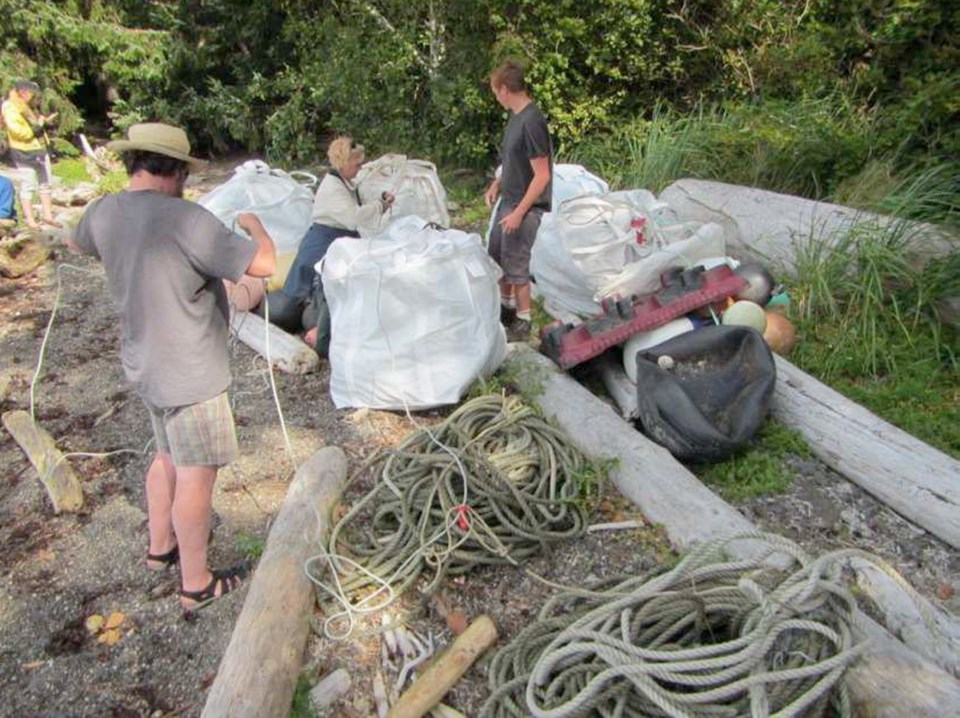Work began Tuesday to clear dozens of beaches on the west coast of Vancouver Island of debris and plastics, much of it washed ashore from the 2011 tsunami that swept Japan.
Using a helicopter, a barge and a tug, volunteers are picking up bundles of garbage from one end of the island to the other.
For months, hundreds of volunteers from seven groups have combed beaches by foot and by boat between Cape Scott in the north and Sooke in the south. They bagged a staggering array of plastic junk and stashed them above the tide line for later removal. More than 40 tonnes of material, including fishing and mooring floats, foam packaging, used oil containers and plastic drinking bottles were assembled.
Now, with the last bits of money provided by the Japanese government for a multi-year tsunami debris cleanup program, members of the Vancouver Island Marine Debris Working Group have hired the tug Westco Rouge out of Campbell River to pick up the junk and take it to Richmond for recycling.
Some of the material will end up in Metro Vancouver’s landfill but most of the material will go to recyclers, said Karen Wristen, executive director of the environmental group Living Oceans Society.
“The tug is at Cape Scott now and is picking up nets of collected plastics. It is moving continuously down the coast. We have cached material on about 60 beaches, and a helicopter will sling them all on to the barge,” she said.
The barge will be brought to River Road Barge and Transfer in Richmond next week. The volunteers are organizing a sorting party for Oct. 1 and 2, and the public is invited to come down and pick up souvenirs.
Not all of the material picked up came from the tsunami, which was generated when the Tohoku earthquake hit Japan, killing 15,893 people, injuring 6,152 and leaving 2,567 missing.
“There is a very high probability that about a third of the stuff that was picked up came from the tsunami,” Wristen said. “The rest of it is stuff that washes ashore.”
But cleaning up the beaches and coastline of plastics is imperative, she said, both for humans and for wildlife. And that’s not accounting for what’s now floating in the ocean.
“The point is, if we leave it there, it is going to end up on our dinner plates. It is being ground down, eaten and passed up the food chain. All of the toxins that accumulate on that plastic are going to wind up in the food chain if we don’t get this off the beach.”
The volunteers have used lost nets found on beaches to hold the debris. As recently as two weeks ago, they were finding new material to take away. But there are many coves and beaches the volunteers couldn’t get into, and much debris will remain right where it is.
No human remains were found, Wristen said. But the oddest thing the searchers recovered was a mannequin in Sea Otter Cove.
“It was in parts but the head provided entertainment around the campfire, featured in a number of tableaus of marine debris,” she said.
The recovery operation is largely weather-dependent. Fog may not stop the barge, but it will ground the helicopter, which is provided by 49 North in Campbell River, according to Rob O’Dea, the project manager.
“Weather is our biggest worry,”O’Dea said in a statement. “We have a window until next Friday that looks good for heli-lifting, provided the seas stay below three metres so the barge can travel. But wind or fog could stall the operation at any point, and that’s costly.”
Wristen said the largest amount of debris was collected by the Nuu-chah-nulth Tribal Council, which amassed about 20 tonnes. Living Oceans collected another 10 tonnes and five other groups assembled the rest.
“It was a collaborative effort by a lot of volunteers and we’re grateful to the Japanese government for their financial support.”
Japan provided a $1 million package in 2012 to assist in cleaning up tsunami debris in B.C. The fund was managed by the provincial government, which this summer distributed $330,000. The largest amount, $115,000, went to the Haida Gwaii Tsunami Debris Committee.



